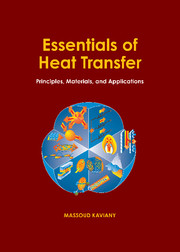Book contents
- Frontmatter
- Contents
- Preface
- Acknowledgments
- Guide to Instructors and Students
- 1 Introduction and Preliminaries
- 2 Energy Equation
- 3 Conduction
- 4 Radiation
- 5 Convection: Unbounded Fluid Streams
- 6 Convection: Semi-Bounded Fluid Streams
- 7 Convection: Bounded Fluid Streams
- 8 Heat Transfer in Thermal Systems
- Nomenclature
- Glossary
- Answers to Problems
- Appendix A Some Thermodynamic Relations
- Appendix B Derivation of Differential-Volume Energy Equation
- Appendix C Tables of Thermochemical and Thermophysical Properties
- Subject Index
1 - Introduction and Preliminaries
Published online by Cambridge University Press: 05 June 2012
- Frontmatter
- Contents
- Preface
- Acknowledgments
- Guide to Instructors and Students
- 1 Introduction and Preliminaries
- 2 Energy Equation
- 3 Conduction
- 4 Radiation
- 5 Convection: Unbounded Fluid Streams
- 6 Convection: Semi-Bounded Fluid Streams
- 7 Convection: Bounded Fluid Streams
- 8 Heat Transfer in Thermal Systems
- Nomenclature
- Glossary
- Answers to Problems
- Appendix A Some Thermodynamic Relations
- Appendix B Derivation of Differential-Volume Energy Equation
- Appendix C Tables of Thermochemical and Thermophysical Properties
- Subject Index
Summary
After countless metamorphoses (i.e., conversions) all energy, unless it is stored (i.e., converted to other than thermal energy), eventually turns into heat and adds its share to the thermal budget.
– H.C. von BaeyerIn this introductory chapter, we discuss some of the reasons for the study of heat transfer (applications and history), introduce the units used in heat transfer analysis, and give definitions for the thermal systems. Then we discuss the heat flux vector q, the heat transfer medium, the equation of conservation of energy (with a reformulation that places q as the central focus), and the equations for conservation of mass, species, and other conserved quantities. Finally we discuss the scope of the book, i.e., an outline of the principles of heat transfer, and give a description of the following chapters and their relations. Chart 1.1 gives the outline for this chapter. This introductory chapter is partly descriptive (as compared to quantitative) in order to depict the broad scope of heat transfer applications and analyses.
Applications and History
Heat transfer is the transport of thermal energy driven by thermal nonequilibrium within amedium or among neighboringmedia. As an academic discipline, it is part of the more general area of thermal science and engineering. In a broad sense, thermal science and engineering deals with a combination of thermal science, mechanics, and thermal engineering analysis and design. This is depicted in Chart 1.2. In turn, thermal science includes thermal physics, thermal chemistry, and thermal biology.
Information
- Type
- Chapter
- Information
- Essentials of Heat TransferPrinciples, Materials, and Applications, pp. 1 - 65Publisher: Cambridge University PressPrint publication year: 2011
Accessibility standard: Unknown
Why this information is here
This section outlines the accessibility features of this content - including support for screen readers, full keyboard navigation and high-contrast display options. This may not be relevant for you.Accessibility Information
- 2
- Cited by
